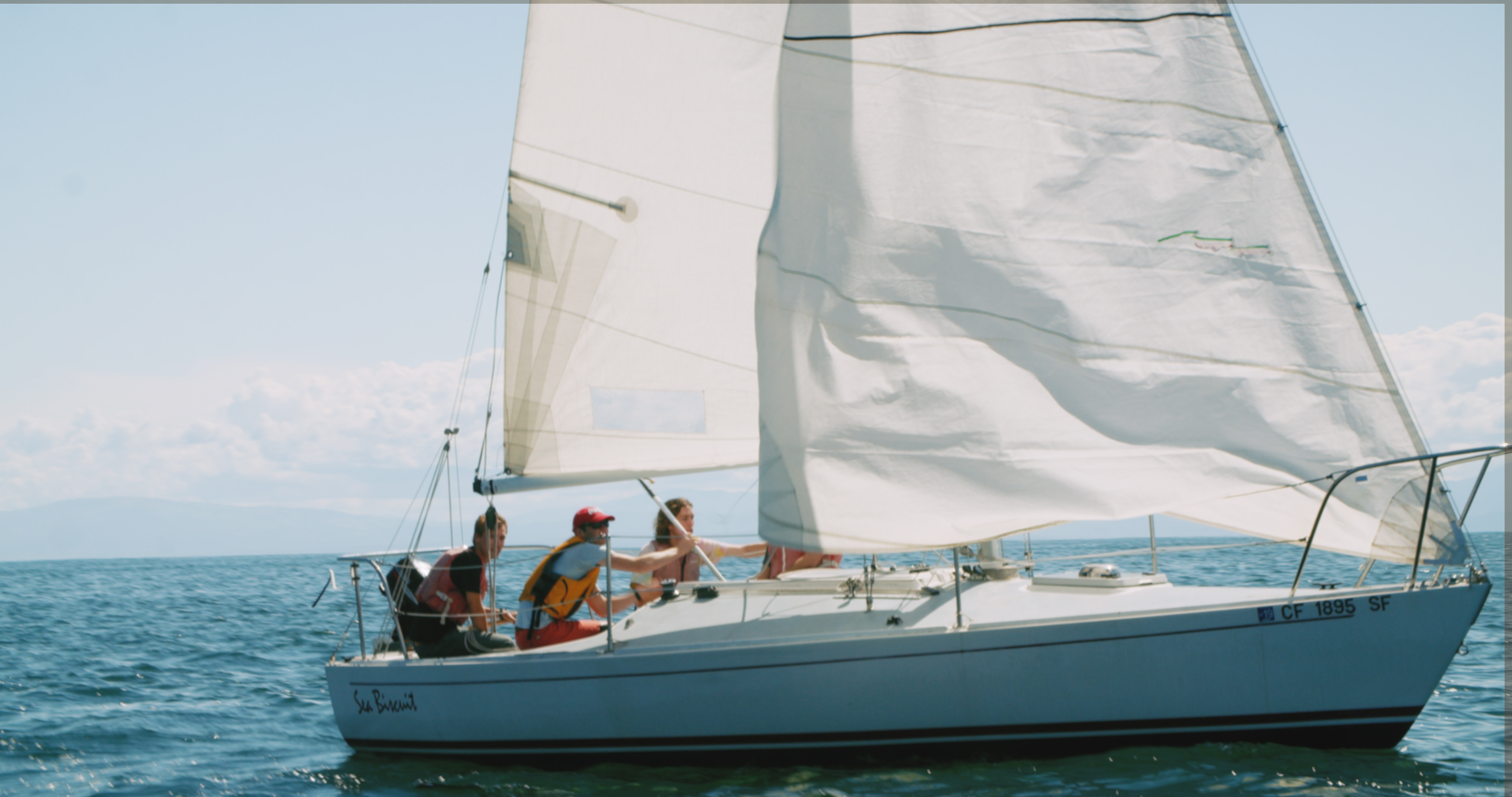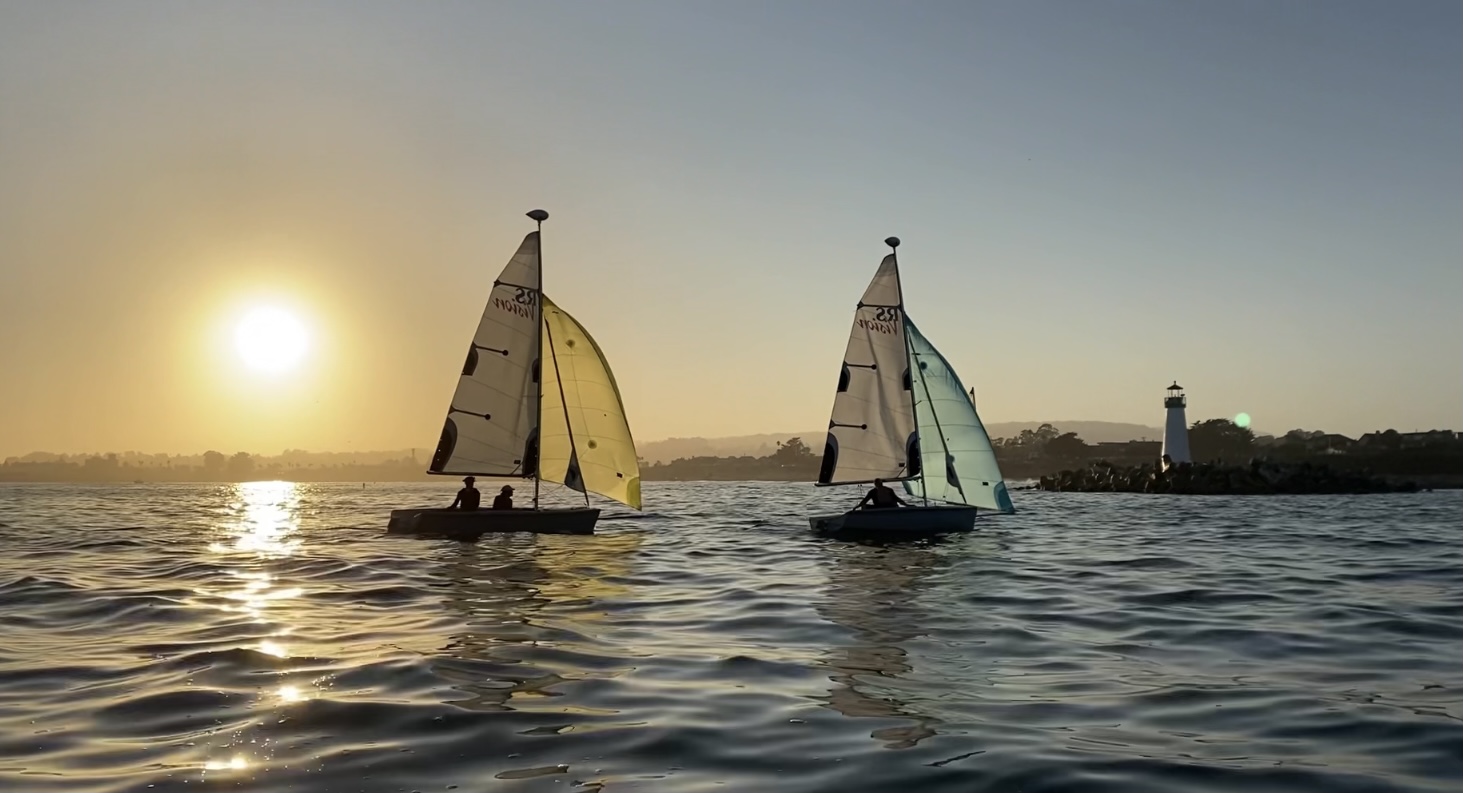Check-out Information | Course Syllabi | Rigging Guides
Check-out Information
Level II Dinghy

The Level 2 dinghy check-out test consists of a written test and an on-the-water skills test.
On the water, be prepared to be tested on:
- Rigging the Quests - Looking for proper rigging of sails and running rigging.
- Towing - While under tow make sure all sheets are un-cleated and steering to maintain control of the vessel.
- Upwind sailing - Once out in bay, we will start to make our way upwind and each boat will complete at least three good tacks (close hauled to close hauled), good communication between skipper and crew is a must
- Points of sail - Each skipper is expected to find all the different points of sail, with proper sail trim, and maintain that course until asked to find the next point of sail.
- Downwind sailing - On the downwind leg, each boat will complete at least three good, controlled jibes. Looking for proper communication between skipper and crew, maintaining control while switching sides, controlling when the main sail comes across, and not over-turning.
- Boat control - Each boat will do three to four laps around the safety boat to demonstrate boat control and proper commands when heading up, falling off, tacking, and jibing.
- Reefing - You may be asked to reef your sail underway.
- Re-entering the harbor - When sailing back through the harbor mouth, make sure you have a good boat position in relation to the western and eastern jetties, while also paying attention to the wind direction, swell, and other boat traffic. Also, make sure to observe proper maritime right-of-way rules.
- Capsize recovery - Once back at the dock, if you have not done a capsize drill with us before or have not done one in the past six months, we will ask you to capsize and right the boat using the scoop-recovery method. If this applies to you, make sure to bring a bathing suit and a towel and/or a change of clothes.
Dinghy Check Out Study Guide (to help you prepare for the written test)
- Rigging
- Points of Sail
- Right of way rules
- Mechanics of the rudder and centerboard
- Proper tacking and jibing
- Scoop-recovery capsize procedure
- Ways to depower your boat
- Santa Cruz Yacht Harbor rules and regulations
- UCSC Community Boating Center rules, regulations, and classifications
- Sailing knots - eight knot, double overhand stopper knot, reef/square knot, clove hitch, round turn with two half hitches, and bowline
Keelboat Checkout

The keelboat check-out test also constitutes a written and an on-the-water skills test. You will be expected to display sufficient skill:
- Dockside:
- Rigging the Santa Cruz 27 - Proper hoisting and tensioning of sails, lines run fairly, and an understanding of all running rigging.
- Checking the outboard - Proper starting technique for any of the outboard engines.
- Leaving the Dock - Proper preparation prior to departure. Good communication while departing slip and good speed control when maneuvering close to other boats.
- Motoring through the channel - Proper channel etiquette and stowage of lines and fenders in preparation of sail hoisting in the bay.
- On the water skills:
- Proper transition from motoring to sailing
- Tacking: 3 quality tacks, both as skipper and crew
- Finding points of sail and maintaining a steady course
- Jibes: 3 quality jibes, both as skipper and crew
- Person overboard drill: You will be expected to execute a Figure 8 drill, hitting appropriate points of sail and stopping the boat next to the victim. (two attempts)
- Reefing while underway
- Heaving to
- Ending sail:
- Returning to Dock - Proper preparation before entering harbor, good seamanship through harbor mouth, and proper preparation prior to entering turning basin. Be prepared to dock with or without the outboard engine (skulling).
- Proper de-rigging of the boat, dock lines properly secured, and engine stowed.
Proper communication with the crew will be evaluated throughout the checkout
Keelboat Check-Out Study Guide:
- Trouble-shooting common problems and gear failure
- Ways to depower your boat
- Person overboard
- Santa Cruz Yacht Harbor rules and regulations
- UCSC Community Boating Center rules, regulations, and classifications
Outboard
The UCSC outboard check-out test consists of a written test and a dockside practical skills test related to both the gas and electric outboards.
For the electric outboards, be prepared to:
- Prepare the engine for sailing:
- Tilt the engine using the stainless handle.
- Lower using the mounting bracket.
- Erect the tiller
- Ask the dockmaster to attach the lithium battery. Only the dockmasters should be handling the batteries.
- Attach the safety line securely to your battery.
- The engine should be powered on before disembarking. The magnetic kill switch must be placed on the tiller for the engine to go into gear.
- Shift smoothly in and out of both gears, pausing in neutral.
- Raise the outboards in the appropriate way.
- Make sure the tiller is off to the side before raising your outboard.
- On the bay:
- You must stop your vessel completely before raising or lowering your outboard.
- You are expected to raise your outboard for sailing.
- End of your sail:
- Before you leave the boat, the outboards should be tilted and raised all the way up on their mounting brackets with the tiller stowed. The engines must be rinsed with fresh water and covered with the correct engine cover.
- Trouble shoot a malfunctioning engine:
- Is the kill switch in place?
- Is there something caught in your propellor?
- Is the battery connection secure?
- Is it displaying an error code? If you have a phone, look it up! It might be easy to fix on the water. Otherwise, reach out to the UCSC office for assistance.
For the gas outboard test, be prepared to:
- Explain how to use choke.
- Explain the critical difference between a water-cooled engine and Maybe's air-cooled engine.
- Lower and raise the gas outboard:
- The correct side up is printed on the outboard. If you turn the outboard upside-down, oil will leak out of the crankcase.
- Make sure not to bump the engine against the transom as you raise or lower.
- Prepare the outboard to start:
- Lower the engine
- Open up the choke
- Open the air vent on the top
- Switch fuel shut-off on starboard side to open
- Bring throttle to "start" position
- Check fuel, fuel line connections
- Check that the kill switch is in place
- You will be asked to start the engine using the pull start.
VHF Radio
The UCSC VHF check-out test consists of a written test and a dockside practical skills test.
You are expected to know:
- Which channels to use to reach different organizations:
- UCSC Dock - Channel 69
- Santa Cruz Harbor Patrol - Channel 9
- Dredge - Channel 8
- Coast Guard and Emergency - Channel 16
- How to make appropriate radio transmissions:
- Hail another vessel or office (ex. UCSC boating center, UCSC boating center, this is Sailing Vessel Lark on channel six nine, over)
- Make a Securite, Pan Pan, or Mayday call (ex. Mayday Mayday Mayday this is 34-foot sailing vessel Captain Joe at *GPS coordinates*. We have a person on board experiencing a heart attack and in need of immediate medical care. We are requesting an evacuation of this individual to the nearest medical facility. Standing by channel one six.)
- The critical differences between calls:
- Securite: pertinant navigational information (ex. aground boat in harbor mouth)
- Pan Pan: non-life-threatening emergency
- Mayday: life-threatening emergency. Nearby boats are required by law to assist.
- How to operate a handheld VHF:
- Adjust Volume and Squelch
- Change channels
- Lock and unlock channel
- Switch between USA, Canada, and International modes:
- Press and hold "16/9" as you click "Clr"
Course Syllabi
These syllabi are conditions and student level-dependent. Most classes diverge from the syllabus at least once over the course of the quarter.
- Beginning Dinghy
- Intermediate Dinghy
- Advanced Dinghy
- Begining Keelboat
- Intermediate Keelboat
- Advanced Keelboat
Rigging

